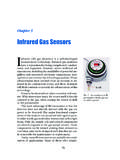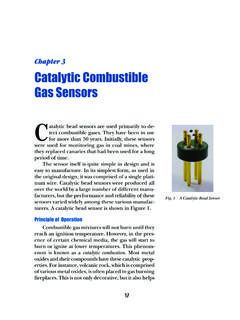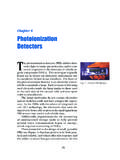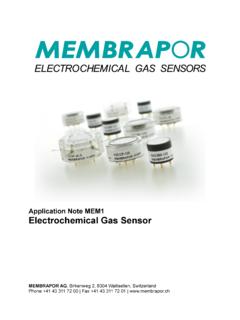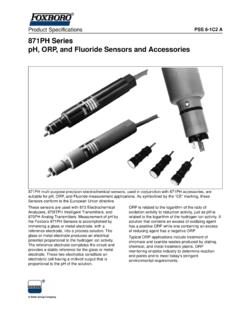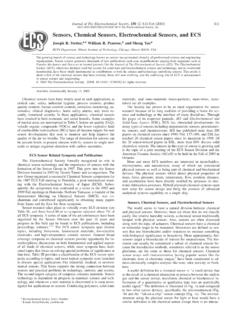Transcription of Chapter 2 Electrochemical Sensors
1 Chapter 2 Electrochemical Sensors Chapter 2. Electrochemical Sensors T. he oldest Electrochemical Sensors date back to the 1950s and were used for oxygen monitoring. More recently, as the Occupational Safety and Health Administration (OSHA) began requiring the monitoring of toxic and combustible gases in confined space applications, new and better Electrochemical Sensors have been developed. By the mid-1980s, miniaturized Electrochemical Sensors became available for detection of many dif- Fig. 1. Electrochemical Sensors ferent toxic gases in PEL ranges, with the Sensors ex- hibiting good sensitivity and selectivity. Currently, a variety of Electrochemical Sensors are being used ex- tensively in many stationary and portable applications for personal safety. Figure 1 shows a small collection of such Electrochemical Sensors . The physical size, geometry, selection of various components, and the construction of an electrochemi- cal sensor usually depends on its intended use.
2 Quite often, the final design results in a compromise between various performance parameters of the electrochemi- cal sensor . The most common misconception about Electrochemical Sensors is that they are all the same. In fact, the appearance of the Electrochemical sen- sors used to detect various gases may be similar, but their functions are markedly different. Consequently, 27. Hazardous Gas Monitors Gas Molecules Micro Ammeter one can expect varying performance from each of these Sensors , in terms of sensitivity, selectivity, re- Anode Cathode sponse time, and operating life. + . For example, a low concentration gas sensor with very high sensitivity uses a coarse-porosity hydrophobic Electrolyte membrane and less restricted capillary to allow more gas molecules to pass through to produce enough sig- Fig. 2 Basic sensor nal for better sensitivity. However, this design also al- lows more of the electrolyte's water molecules to es- cape out to the environment.
3 In other words, an elec- trochemical sensor with high sensitivity would have a relatively short operating life due to evaporation of moisture through the porous membrane. Similarly, the electrolyte composition and the sens- ing electrode material is selected based on the chemi- cal reactivity of the target gas. By careful selection of the electrolyte and/or the sensing electrode, one can achieve the selectivity towards the target gas, but the sensitivity may be reduced. In summary, different Electrochemical Sensors may appear very similar, but are constructed with differ- ent materials including such critical elements as sens- ing electrodes, electrolyte composition, and porosity of hydrophobic barriers. Additionally, some electro- chemical Sensors use external electrical energy to make them reactive to the target gas. All components of the Sensors play a crucial role in determining the overall characteristics of the Sensors .
4 Principle of Operation Capillary Diffusion Electrochemical Sensors operate by reacting with Barrier Hydrophobic the gas of interest and producing an elec- Membrane trical signal proportional to the gas concen- Sensing Electrode tration. A typical Electrochemical sensor con- Reference Electrode sists of a sensing electrode (or working elec- Counter Electrode trode), and a counter electrode separated by a Electrolyte thin layer of electrolyte, Figure 3. Fig. 3 Typical Electrochemical sensor Setup Gas that comes in contact with the sensor 28. Chapter 2 Electrochemical Sensors first passes through a small capillary-type opening and then diffuses through a hydrophobic barrier, and even- Water and Gas tually reaches the electrode surface. This approach is adopted to allow the proper amount of gas to react at the sensing electrode to produce a sufficient electri- cal signal while preventing the electrolyte from leak- Hydrophobic ing out of the sensor , Figure 4.
5 Membrane The gas that diffuses through the barrier reacts at Gas the surface of the sensing electrode involving either an oxidation or reduction mechanism. These reactions are Fig. 4 HydrophobicElectrolyte Membrane: catalyzed by the electrode materials specifically devel- prevents liquid electrolyte from oped for the gas of interest. leaking out. With a resistor connected across the electrodes, a current proportional to the gas concentration flows be- tween the anode and the cathode. The current can be measured to determine the gas concentration. Because a current is generated in the process, the electrochemi- cal sensor is often described as an amperometric gas sensor or a micro fuel cell. Importance of a Reference Electrode. For a sen- sor requiring an external driving voltage, it is impor- tant to have a stable and constant potential at the sens- ing electrode.
6 In reality, the sensing electrode potential does not remain constant due to the continuous elec- trochemical reaction taking place on the surface of the electrode. It causes deterioration of the performance of the sensor over extended periods of time. To improve the performance of the sensor , a reference electrode is introduced. This reference electrode is placed within the elec- trolyte in close proximity to the sensing electrode. A. fixed stable constant potential is applied to the sens- ing electrode. The reference electrode maintains the value of this fixed voltage at the sensing electrode. No current flows to or from the reference electrode. The gas molecules react at the sensing electrode and the current flow between the sensing and the counter elec- trode is measured and is typically related directly to 29. Hazardous Gas Monitors the gas concentration.
7 The value of the voltage applied to the sensing electrode makes the sensor specific to the target gas. The micro fuel cell-type Electrochemical Sensors do not require an external driving voltage. For example, an elec- trochemical sensor specific to oxygen has an anode, ei- ther Pb or Cd, that supplies electrons for the reduction of oxygen at the cathode. During the oxidation of the an- ode, the electrons are released which then travel via an external circuit to the cathode where oxygen molecules consume the electrons as follows: In acidic electrolyte Oxidation at the anode: 2Pb + 2H2O 2 PbO + 4H+ + 4e- Reduction at the cathode: O2 + 4H+ + 4e- 2H2O. In basic electrolyte Oxidation at the anode: 2Pb + 4OH- 2 PbO + 2H2O + 4e- Reduction at the cathode: O2 + 2H2O + 4e- 4OH- The overall reaction in both cases is: 2Pb + O2 2 PbO. These types of Sensors do not require a reference electrode.
8 Major Components An Electrochemical sensor consists of the following ma- jor components: A. Gas Permeable Membrane (also called hydrophobic membrane): This is used to cover the sensor 's sens- ing (catalyst) electrode and, in some instances, to control the amount of gas molecules reaching the electrode surface. Such barriers are typically made of thin, low-porosity Teflon membranes. Such sen- sors are called membrane clad Sensors . Alternatively, the sensing electrode is covered with a high-poros- ity Teflon and the amount of gas molecules reach- ing the electrode surface is controlled by a capil- 30. Chapter 2 Electrochemical Sensors lary. Such Sensors are referred to as capillary-type Sensors . Besides offering a mechanical protection to the sensor , the membrane performs the additional function of filtering out unwanted particulates. Se- lecting the correct pore size of the membrane and capillary is necessary to transfer the proper amount of gas molecules.
9 The pore size should be such as to allow enough gas molecules to reach the sensing electrode. The pore size should also prevent liquid electrolyte from leaking out or drying out the sen- sor too quickly. B. Electrode: The selection of the electrode mate- rial is very important. It is a catalyzed material which performs the half cell reaction over a long period of time. Typically, the electrode is made from a noble metal, such as platinum or gold, and catalyzed for an effective reaction with gas mol- ecules. Depending on the design of the sensor , all three electrodes can be made of different materi- als to complete the cell reaction. C. Electrolyte: The electrolyte must facilitate the cell reaction and carry the ionic charge across the elec- trodes efficiently. It must also form a stable refer- ence potential with the reference electrode and be compatible with materials used within the sensor .
10 If the electrolyte evaporates too quickly, the sensor 's signal will deteriorate. D. Filter: Sometimes a scrubber filter is installed in front of the sensor to filter out un- wanted gases. There is a limited selec- Capillary Diffusion tion of filters, each with different de- Barrier Charcoal Filter grees of effectiveness. The most com- monly used filter medium is activated Sensing Electrode charcoal, as shown in Figure 5. The ac- Reference Electrode tivated charcoal filters out most chemi- Counter Electrode cals with the exception of carbon mon- Electrolyte oxide and hydrogen gases. By properly Fig. 5 Filtering with Activated Charcoal selecting the filter medium, an elec- 31. Hazardous Gas Monitors trochemical sensor can be made more selec- Typical Gases and the Range of Measurement of tive to its target gases. Electrochemical Sensors Choosing the suitable materials for the above components, and arranging the geometry of all these GAS NAME PPM RANGE.


